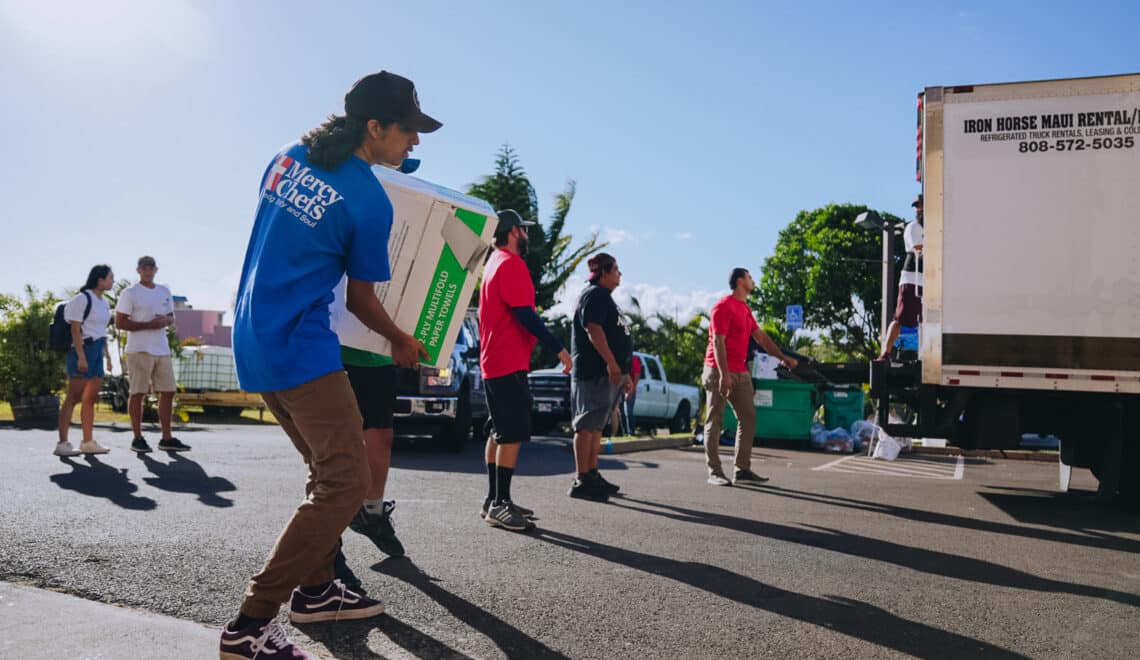Keep calm (drop everything) and start pitching during a media relations crisis response

When Mercy Chefs, a Virginia-based disaster relief and humanitarian aid organization, springs into action at a moment’s notice, our account team follows suit with an all-hands media relations approach.
Most recently, the team — known for its quick response and dedication to serving hot, chef-prepared meals during natural disasters and national emergencies – provided aid to Maui after wildfires ravaged the community of Lahaina. Mercy Chefs is currently serving thousands of meals a day, and it’s our job to make sure that the world knows about it.
Disaster relief efforts are critical moments where effective communication plays a significant role in coordinating resources, driving awareness and providing support to victims and first responders.
After working on the Mercy Chefs account for the last three years and providing media relations support on deployments from Ukraine to Puerto Rico, and all over the U.S., I’ve learned a thing or two about disaster relief media relations and a few things that make our work successful.
Timeliness and accuracy are key
When disaster strikes, the news spreads rapidly. Media outlets, both local and national, seek accurate information to report. As a media relations professional, ensure that your communication is timely and accurate – which could mean adjusting your working hours to ensure you’re online when local media is online. Coordinate closely with your disaster relief team on the ground and back home to provide consistent updates on their efforts, including the number of meals served, locations and any logistical challenges faced. Fact-checking is critical. Double-check your work, check it again and then send it to your colleague for good measure.
Build a strong media list
A strong media list is the foundation of a successful pitching strategy. Asking yourself questions like who covered the team on previous deployments and who is currently on the ground are important in the first few hours. These connections are vital when it comes to spreading the client’s message far and wide. By taking the time to research reporters who align with your message, you ensure that your story doesn’t just make noise—it resonates.
Utilize multiple channels
Disaster relief media relations requires a multi-channel approach to ensure that everyone stays on the same page –sometimes across multiple different time zones. For Mercy Chefs, we usually maintain a group chat with all the key players. That would include your main client, the point of contact that is on the ground and coordinating interviews, as well as the interviewee themself. This helps when you need to get answers and updates fast – something that email doesn’t always provide.
While emails and text threads are flowing, we also like to keep a live interview request doc updated with all the current opportunities that are pending, confirmed or completed. This includes the outlet, the day/time with the time zone, the person who will be interviewed, the Zoom link (if virtual) and the status of the interview. This will ensure that nothing falls between the cracks.
Share pictures when you can
In the age of social media and digital communication, visual content is crucial. Make sure you can get your hands on high-quality photos and videos that document your client’s relief efforts on the ground. Photos that showcase volunteers preparing meals, interactions with people on the ground and the distribution process are the bread and butter for reporters looking to craft an engaging story. These visuals create a deeper connection with the audience and provide a window into the organization’s activities on the ground. It’s great to share photos through a link that can be updated and kept fresh with the latest assets.
Empathy, empathy and more empathy
Disasters bring about BIG emotions and challenges for affected communities, media members and sometimes for your client themselves. For this specific deployment, our client had family on Maui who were experiencing the devastation first-hand, and we tried to keep that top of mind when communicating with them.
Show genuine compassion in your communications, and don’t forget that at the end of the day, we are all humans. Prioritize the wellbeing of the people you’re working with. And don’t forget that a well wish goes a long way.
Author’s Note: Mercy Chefs has now served more than 35,000 meals to wildfire victims, volunteers, and first responders on Maui. The team is currently offering lunch and dinner service from Citizen Church Maui in Lahaina and is beginning the transition to longer-term recovery efforts through Family Grocery Boxes. These grocery boxes are packed with everything a family needs to prepare meals for themselves: produce, fruit, canned meat, pasta, rice, sugar, flour, and more.
To learn more about the work of Mercy Chefs, visit www.mercychefs.com.
Leave a Reply